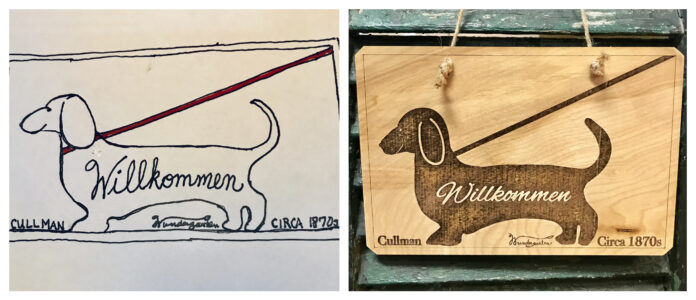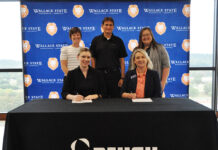
WILLKOMMEN! Dear reader, did you grow up with Cullman’s “Legend of the Smiling Dachshund” sign? My tireless, hard-working parents told me the story one summer when I was an ambitious kid delivering Grit newspapers door to door. For every 10-cent newspaper, Grit publishers would get 7 cents, and we newsies were delighted to keep 3.
“If you have a good attitude and you are willing to work hard, Cullman is a welcoming place.” That was the message I learned from the smiling dachshund. I recently recalled this legend when local merchant Rob Werner shared his family’s colorful story as last month’s program for the Cullman Historical Society.
The Werner place, his great-great-grandparents’ home, was a big, rambling house built in Cullman during the 1880s. The location was where the pine thicket next to the railroad tracks is presently when you look toward the east from the community donations loading dock of The Foundry Thrift Store.
At the Cullman Historical Society meeting, Rob shared three things that stuck with me:
1) The roof of the Werners’ house was tin instead of the customary wood shingles. This was because locomotives of that Colonial Cullman era were spitting out burning embers and a tin roof provided greater fire safety. Rob remembers the sound of raindrops falling on that tin roof.
2) The Werners grew tobacco. Honestly, in all my time studying Cullman County’s early history, this was a first to hear about local tobacco growing. As a gardener, I assumed Alabama humidity would cause too much leaf mold for tobacco to grow. Rob remembered a smoke chimney his ancestors used to cure their tobacco.
3) Now, back to the Legend of the Smiling Dachshund sign. Rob talked about how people looking for work would often get off the train in Cullman. The Werners and other locals would regularly give them meals and shelter in exchange for labor.
Colonial Cullman, that era from 1870 to the Colonel’s death in 1895, thrived like a wundergarten, not by magic like a fairytale but by the hard work of the mostly German farmers. During that time period when Cullman was a German colony, all business transactions were conducted in German. Many of those 19th century train travelers were illiterate and almost none spoke German. So, a sign like that of a smiling dachshund puppy would let people with a good attitude and a willingness to work know where to find jobs.
After Rob’s talk, I drew a rough sketch of the smiling dachshund as I imagined it since my childhood, then shared it with Cullman wood crafter, Leldon Maxcy. In turn, Leldon crafted the charming, vintage-looking sign. That’s the origin story of The Smiling Dachshund that would welcome, or willkommen, all to the wundergarten.
In this storytelling culinary series, “Celebrating in the Wundergarten,” we are imagining German dishes from the recipe box of Fraulein Ruehl, the heroine of the folktale “Wundergarten.”
In 2023, both the City of Cullman and The Cullman Tribune, Alabama’s oldest continuously published weekly newspaper and Cullman County’s oldest business, are celebrating their 150th birthdays. But, for 21st century cooks, our celebratory recipes embrace modern ease and have a greater array of ingredients than Frau Ruehl would have had in her pantry.
German Americans introduced the frankfurter to our country, and we think Cullman County, Alabama should have THE BEST HOTDOG IN THE UNITED STATES.
THE CULLMAN DOG
BEST HOT DOG WEINER—Our crowd-sourced votes were split between Ballpark Franks and Nathan’s Famous
BEST HOT DOG BUN—Hinkel buns got the vote and there are recipes online; don’t skimp on bun quality- #goodbunsmatter
BEST SAUERKRAUT—Homemade red cabbage kraut gets our vote, and a recipe will be shared later in this series; for now, grab a jar of Hengstenberg Bavarian-Style Sauerkraut or Bubbies Sauerkraut
BEST KETCHUP—Heinz, which was founded by H.J. Heinz, a son of German immigrants, in 1869; at one time, Colonel Cullman and H.J. Heinz both lived in Pennsylvania and being contemporary, German American visionaries, likely knew each other; I am exploring that angle with the Cullman History Museum for a future story—the deep-pocketed Heinz Foundation could be a good source for funding needed at the Cullman County Master Gardeners revitalization efforts at the Woodlands and Wildflower Garden at Cullman County’s grandest park, Sportsman Lake.
BEST PICKLES—Wickles Pickles is a great, Alabama-made choice; and Smickles “fine craft” Pickles are also tasty. I once took a “canning class” offered by the Cullman County office of the Alabama Cooperative Extension Service, and I am here to testify some of “the best pickles on the planet” are on the pantry shelves of Cullman’s pickle-packin’ mamas and papas.
BEST MUSTARD—This is an easy, made-from-scratch mustard recipe, Frau Ruehl, the heroine of “Wundergarten” would magically conjure to serve on Cullman Dog frankfurters and bratwurst. The black mustard seeds bring the heat, and the brown sugar, garlic, tarragon and spices add flavor.
WUNDERGARTEN GERMAN-STYLE, FRESH MUSTARD
(Source: thespruceeats.com)
INGREDIENTS
- 1/4 cup yellow mustard seeds
- 2 1/2 tbsp. black or brown mustard seeds
- 1/4 cup dry mustard powder
- 1/2 cup water
- 1 1/2 cups cider vinegar
- 1 small onion, chopped
- 2 tbsp. firmly packed brown sugar
- 1 tsp. salt
- 2 cloves garlic, minced, or pressed
- 1/2 tsp. ground cinnamon
- 1/4 tsp. ground allspice
- 1/4 tsp. dried tarragon
- 1/8 tsp. ground turmeric
DIRECTIONS
- In a medium bowl, combine the mustard seed and dry mustard.
- In a 1-to-2-quart, stainless steel or non-reactive saucepan, combine the rest of the ingredients. Simmer, uncovered, over medium heat until the mixture is reduced by half, which will take 10 to 15 minutes.
- Pour the mixture into the bowl with the mustard seed. Let it stand, covered, at room temperature for 24 hours. You may have to add more vinegar to keep enough liquid in the mixture to adequately cover the seeds.
- Process the mixture in a blender or food processor until it is blended to the texture you like; this can take 3 or 4 minutes. You can leave it with some whole seeds remaining or make a smoother paste.
- Scrape mustard into clear, dry jars. Cover them tightly and place in the refrigerator for at least one day, but preferably three, to allow flavors to meld. (The mixture will continue to thicken. If it gets too thick after a few days, stir in additional vinegar.)
- Slather on your smile-making Cullman Dog!
AUF WIEDERSEHEN and WOOF! WOOF!
Find all columns in this series at www.cullmantribune.com/tag/celebrating-in-the-wundergarten.


























